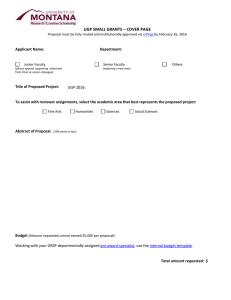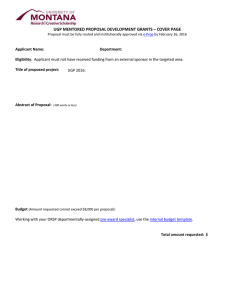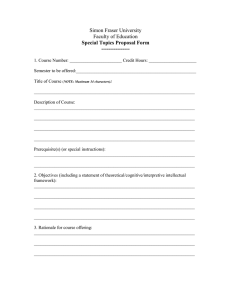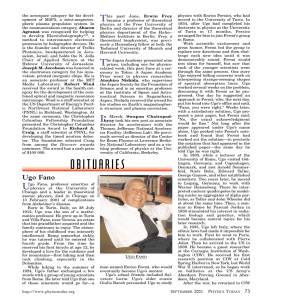FLOW CONTROL IN TIME-VARYING, RANDOM SUPPLY CHAINS
advertisement
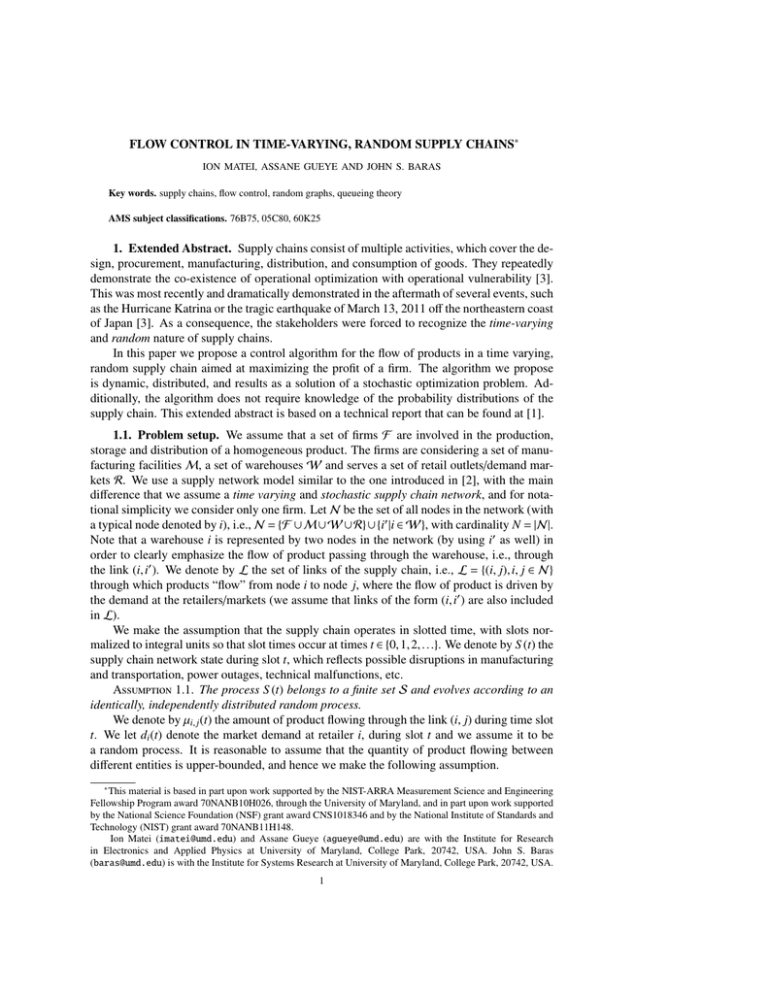
FLOW CONTROL IN TIME-VARYING, RANDOM SUPPLY CHAINS∗
ION MATEI, ASSANE GUEYE AND JOHN S. BARAS
Key words. supply chains, flow control, random graphs, queueing theory
AMS subject classifications. 76B75, 05C80, 60K25
1. Extended Abstract. Supply chains consist of multiple activities, which cover the design, procurement, manufacturing, distribution, and consumption of goods. They repeatedly
demonstrate the co-existence of operational optimization with operational vulnerability [3].
This was most recently and dramatically demonstrated in the aftermath of several events, such
as the Hurricane Katrina or the tragic earthquake of March 13, 2011 off the northeastern coast
of Japan [3]. As a consequence, the stakeholders were forced to recognize the time-varying
and random nature of supply chains.
In this paper we propose a control algorithm for the flow of products in a time varying,
random supply chain aimed at maximizing the profit of a firm. The algorithm we propose
is dynamic, distributed, and results as a solution of a stochastic optimization problem. Additionally, the algorithm does not require knowledge of the probability distributions of the
supply chain. This extended abstract is based on a technical report that can be found at [1].
1.1. Problem setup. We assume that a set of firms F are involved in the production,
storage and distribution of a homogeneous product. The firms are considering a set of manufacturing facilities M, a set of warehouses W and serves a set of retail outlets/demand markets R. We use a supply network model similar to the one introduced in [2], with the main
difference that we assume a time varying and stochastic supply chain network, and for notational simplicity we consider only one firm. Let N be the set of all nodes in the network (with
a typical node denoted by i), i.e., N = {F ∪ M ∪ W ∪ R} ∪ {i′ |i ∈ W}, with cardinality N = |N|.
Note that a warehouse i is represented by two nodes in the network (by using i′ as well) in
order to clearly emphasize the flow of product passing through the warehouse, i.e., through
the link (i, i′ ). We denote by L the set of links of the supply chain, i.e., L = {(i, j), i, j ∈ N}
through which products “flow” from node i to node j, where the flow of product is driven by
the demand at the retailers/markets (we assume that links of the form (i, i′ ) are also included
in L).
We make the assumption that the supply chain operates in slotted time, with slots normalized to integral units so that slot times occur at times t ∈ {0, 1, 2, . . .}. We denote by S (t) the
supply chain network state during slot t, which reflects possible disruptions in manufacturing
and transportation, power outages, technical malfunctions, etc.
Assumption 1.1. The process S (t) belongs to a finite set S and evolves according to an
identically, independently distributed random process.
We denote by µi, j (t) the amount of product flowing through the link (i, j) during time slot
t. We let di (t) denote the market demand at retailer i, during slot t and we assume it to be
a random process. It is reasonable to assume that the quantity of product flowing between
different entities is upper-bounded, and hence we make the following assumption.
∗ This material is based in part upon work supported by the NIST-ARRA Measurement Science and Engineering
Fellowship Program award 70NANB10H026, through the University of Maryland, and in part upon work supported
by the National Science Foundation (NSF) grant award CNS1018346 and by the National Institute of Standards and
Technology (NIST) grant award 70NANB11H148.
Ion Matei (imatei@umd.edu) and Assane Gueye (agueye@umd.edu) are with the Institute for Research
in Electronics and Applied Physics at University of Maryland, College Park, 20742, USA. John S. Baras
(baras@umd.edu) is with the Institute for Systems Research at University of Maryland, College Park, 20742, USA.
1
2
Assumption 1.2. The flows µi, j (t) are positive for all time-slots t and there exist positive
scalars µmax
such that
i
∑
µi,b (t) ≤ µmax
, ∀i ∈ N, ∀(i, b) ∈ L, ∀t.
i
(1.1)
b
The following definitions introduce the time averages of the product flows in the supply
chain.
Definition 1.3. The time average flows of product and their long-run time averages,
respectively are given by
1∑
E{µi, j (τ)}, µ̄i, j = lim µ̄i, j (t), ∀(i, j) ∈ L.
t→∞
t
t−1
µ̄i, j (t) =
(1.2)
τ=0
Additionally, we have the following assumption on the market demands.
Assumption 1.4. The market demands di (t) are independent and identically distributed
random processes with mean given by
d̄i = E{di (t)}, ∀i ∈ R.
(1.3)
Let us also define the aggregate vectors of product flows µ(t) = (µi, j (t), (i, j) ∈ L), and market
demands d(t) = (di (t), i ∈ M).
1.2. Flow control algorithm and performance results. We assume that the revenue
function of the firm depends on the quantity of products that reach the retailers/markets in the
long-run and we denote it by
∑
f (µ̄) =
fi′ , j (µ̄i′ , j ),
i∈W, j∈R
for i ∈ W, j ∈ R and (i′ , j) ∈ L. We also consider a cost function associated with each link
(i, j) ∈ L which we denote by gi, j (µ̄i, j ). These cost functions depend on the flow of product
on the links and are generated by activities such as acquiring raw materials, manufacturing,
transportation or warehouse usage. The total cost function is given by
g(µ̄) =
∑
∑
gi, j (µ̄i, j ) +
i∈F , j∈M
∑
gi, j (µ̄i, j ) +
i∈M, j∈W
gi,i′ (µ̄i,i′ ) +
i∈W
∑
gi′ , j (µ̄i′ , j ).
i∈W, j∈R
Assumption 1.5. The functions fi, j are non-negative, continuously differentiable and
concave, while the functions gi, j are non-negative, continuously differentiable and convex.
We define the long-run profit function h as the difference between the revenue and the
cost functions, i.e.,
h(µ̄) = f (µ̄) − g(µ̄).
We introduce the following stochastic optimization problem,
h(µ̄)
max
µ̄
subject to:
∑
µ̄a,i =
a∈F
µ̄i′ ,i =
∑
µ̄i,b , ∀i ∈ M,
b∈W
∑
b∈R
µ̄i′ ,b , ∀i ∈ W,
(1.4)
∑
µ̄a,i = µ̄i,i′ , ∀i ∈ W,
a∈M
∑
µ̄a′ ,i ≤ d̄i , ∀i ∈ R.
a∈W
where µ̄i, j = E{µi, j (t)} for all (i, j) ∈ L.
In what follows we describe a randomized flow control algorithm, which picks values
for µi, j (t) at each time instant based only on local knowledge of the state S (t) of the supply
chain at time t. The main idea of the algorithm consists of replacing the equality constrains
3
with two inequality constraints and associating to each of the inequality constraints a queue.
For example
∑
∑
µ̄a,i =
a∈F
is replaced by
∑
µ̄a,i ≤
a∈F
∑
µ̄i,b , ∀i ∈ M
b∈W
µ̄i,b ,
b∈W
∑
µ̄a,i ≥
a∈F
∑
µ̄i,b , ∀i ∈ M.
b∈W
To the first and the second previous inequalities we associate the following two queues with
dynamics, respectively
∑
µi,b (t), 0
+
µa,i (t), ∀i ∈ M,
a
b
∑
2
∑
2
Ui (t + 1) = max
Ui (t) −
µa,i (t), 0
+
µi,b (t), ∀i ∈ M.
1
Ui1 (t + 1) = max
U (t) −
i
∑
a
(1.5)
(1.6)
b
In addition to the queues introduced in (1.5) and (1.6), we define queues corresponding to
the rest of the constraints, with dynamics given by
∑
{
} ∑
2
1
2
′
Ui (t) − µi,i (t), 0 +
µa,i (t), Ui (t + 1) = max
Ui (t) −
µa,i (t), 0
+ µ ′ (t), ∀i ∈ W,
i,i
a
a
∑
{
} ∑
1
1
Ui′ (t + 1) = max
U (t) −
µi′ ,b (t), 0
+ µ ′ (t), Ui2′ (t + 1) = max Ui2′ (t) − µi,i′ (t), 0 +
µi′ ,b (t), ∀i ∈ W
i′
i,i
Ui1 (t + 1) = max
b
b
{
} ∑
Ui (t + 1) = max Ui1 (t) − di (t), 0 +
µa,i (t), ∀i ∈ R.
a
1.3. Flow control algorithm. Next, we describe an algorithm that not only stabilizes
the queues but also gets arbitrarily close to the optimal solution of (1.4). The closeness is
characterized by a positive scalar δ, used as a parameter in the algorithm.
• Control of the raw material flow: At each time t it chooses the amount µ1,b of raw
material sent to manufacturer b, where µ1,b is the solution of the following optimization problem:
min
µ1,b
subject to:
∑(
[
]
)
δ g1,b (µ1,b ) + Ub1 (t) − Ub2 (t) µ1,b
b∈M
∑
µ1,b ≤ µmax
1 , µ1,b ≥ 0, ∀b.
b∈M
• Control of the flow of product from the manufacturers to the warehouses: The
amount of product sent to each warehouse b at time slot t is given by µi,b , obtained
as solution of the following optimization problem:
min
µi,b
subject to:
∑
b
])
] [
([
δ gi,b (µi,b ) − Ui1 (t) − Ub1 (t) + Ub2 (t) − Ui2 (t) µi,b
∑
µi,b ≤ µmax
, µi,b ≥ 0, ∀b,
i
b∈W
for all i ∈ M, b ∈ W and (i, b) ∈ L which are active at time t, as per the state of the
supply chain given by S (t).
4
• Control of the flow of product within the warehouses: The amount of product allowed in the warehouse at time slot t is given by µi,i′ , obtained as solution of the
following optimization problem:
([
] [
])
minδgi,i′ (µ) − Ui1 (t) − Ui1′ (t) + Ui2′ (t) − Ui2 (t) µ
µ
0 ≤ µ ≤ µmax
i
subject to:
for all i ∈ W and (i, i′ ) ∈ L which are active at time t, as per the state of the supply
chain given by S (t).
• Control of the flow of product from the warehouse to retailers: The amount of product sent to the retailer b at time slot t is given by µi′ ,b , where µi′ ,b are obtained as
solution of the following optimization problem:
min
µi′ ,b
∑
[(
)
]
δ gi′ ,b (µi′ ,b ) − δ fi′ ,b (µi′ ,b ) − Ui1′ (t) − Ub1 (t) − Ui2′ (t) µi′ ,b
b∈R
∑
subject to:
µi′ ,b ≤ µmax
i′ , µi′ ,b ≥ 0, ∀b,
b∈R
(i′ , b)
for all i ∈ W, b ∈ R and
supply chain given by S (t).
∈ L which are active at time t, as per the state of the
1.4. Performance of the algorithm. Let µ∗ and h∗ be the optimal solution and cost
value, respectively of the optimization problem (1.4). The next Theorem describes the performance of the flow control algorithm.
Theorem 1.6. Let Assumptions 1.1 through 1.5 hold. For any positive parameter δ the
flow control algorithm described in Section 1.3 stabilizes the (virtual) queues associated with
the constraints of the optimization problem (1.4) and gives the following upper bounds:
t−1 2
∑
∑
1 ∑ ∑ ∑
j
j
j
lim sup
E{Ui (τ)} +
E{Ui (τ) + Ui′ (τ)} +
E{Ui (τ) ≤ c1 + c2 δ
t→∞ t
τ=0 j=1 i∈W
lim inf h(µ̄(t)) ≥ h(µ∗ ) −
t→∞
(1.7)
i∈R
i∈M
c3
,
δ
(1.8)
where c1 , c2 and c3 are positive scalars depending on the parameters of the problem.
Note that inequality (1.7) shows that under the flow control algorithm, the queues remain stable, i.e., the long-run time averages of the flows are feasible. In addition, inequality
(1.8) shows that under the flow control algorithm we can get arbitrarily close to the optimal
solution, by making δ arbitrarily large.
REFERENCES
[1] I. Matei, A. Gueye, and J.S. Baras, Flow control in time-varying, random supply chain networks, ISR Technical
Report 2012-04, University of Maryland (available at:http://hdl.handle.net/1903/12479), (2012).
[2] A. Nagurney, Supply chain network design under profit maximization and oligopolistic competition, Transportation Research E, (2010), pp. 281–294.
[3] I. Varkony, Critical infrastructure protection: Volatility and risks in the global chain, The CIP Report on
Global Supply Chain, (2011).
